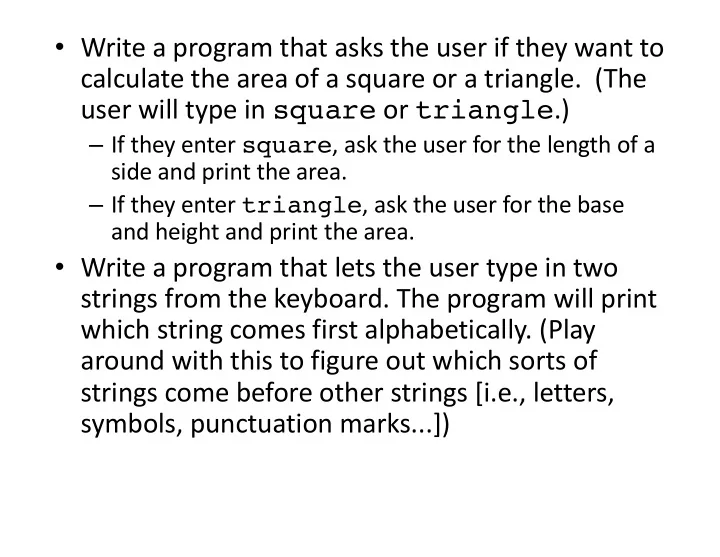

• Write a program that asks the user if they want to calculate the area of a square or a triangle. (The user will type in square or triangle .) – If they enter square , ask the user for the length of a side and print the area. – If they enter triangle , ask the user for the base and height and print the area. • Write a program that lets the user type in two strings from the keyboard. The program will print which string comes first alphabetically. (Play around with this to figure out which sorts of strings come before other strings [i.e., letters, symbols, punctuation marks...])
Fact of the Day: When programming languages were first developed, they usually included a statement called GOTO that permitted a program to jump from one line of code to another line of code at any time. This was used to implement things like if-else statements. In the 1960s- 80s, using GOTO was strongly discouraged because it can lead to unmaintainable "spaghetti code." Programming with if- else statements and other "higher-level" language constructs is known as structured programming.
Multiple tests at once
Multiple tests at once if _______ and _______ : # do something else: # do something else Both individual tests must be True to make the entire if statement True .
Multiple tests at once if _______ or _______ : # do something else: # do something else Either (or both) individual tests must be True to make the entire if statement True .
TN passes a new law that says you can't drink once you reach the age of 80. age = int(input("What is your age? ")) if _________________________ : print("You may drink!") else: print("You can't drink!")
You're writing an app that monitors the thermostat in your house and alerts you if the house temperature drops to 50 degrees or rises to 90 degrees. temp = read temperature somehow… if _________________________ : # send a temperature alert here print("It's uncomfortable in here!")
Comparison of if vs if-else
Statement test is True IF Statement Statement test is False Statement Statement Statement Statement
The condition if condition : must be something statement that is True or False. statement more statements… statement statement more statements…
Statement IF condition is False condition is True Statement Statement Statement Statement Statement Statement
if condition : statement more statements… else : statement more statements… more statements…
Statement IF option 1 option 2 more … Statement Statement Statement Statement Statement Statement Statement Statement
if condition1 : statements… elif condition2 : statements… elif condition3 : statements… (etc) else : statements…
• Python runs each test in a group in order, top to bottom. • Once a test is found that is True , the corresponding statements are run, and the rest of the tests and statements are ignored. x = 5 if x < 2: print("A") elif x < 6: print("B") elif x < 10: print("C")
• Any new " if " creates a new group, independent of any previous if / elif / else . x = 5 x = 5 if x < 2: if x < 2: print("A") print("A") elif x < 6: elif x < 6: print("B") print("B") elif x < 10: if x < 10: print("C") print("C")
Let's say a class has a grading scale of: A = 90 and above B = 80-89 C = 70-79 D = 60-69 F = below 60
Two more things... OK to mix and s and or s, but you should parenthesize them: if ( x > 10 and x < 100 ) or x < 0: is different than if x > 10 and ( x < 100 or x < 0 ) : Consider when x = -1.
If you ever want to negate a test, you can use not: if x > 3: print("Yes!") if not (x <= 3): print("Yes!") and/or/not can be combined in any fashion, using parentheses to specify how they should be interpreted.
• See lab handout
Recommend
More recommend